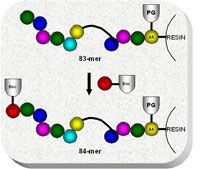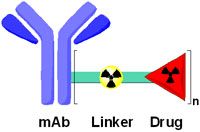Carbon-14 Bioconjugation: Peptides and Antibody-Drug Conjugates
The authors explain how the synergy between peptide and protein technology and radiolabeling groups can enable the manufacture of carbon-14 labeled peptides and antibody-drug conjugates.
A CMO offering a peptide and protein technology (PPT) service coupled with a radiolabeling facility is in a unique position to supply GMP-quality carbon-14 labeled peptides and antibody drug conjugates (ADCs) to the biopharmaceutical industry and CROs. These carbon-14 labeled peptides can be used as drug therapies, antibodies, disease mechanism probes, or in assay development. The technology transfer and manufacturing experience provided by such a synergy enables the production of a wide range of carbon-14 labeled peptides and ADCs from an MHRA-inspected and certified GMP facility and enables a complete first-in-human package and regulatory support toward the management of investigational drugs.
Only a limited number of CMOs can offer the manufacture of carbon-14 or unlabeled custom peptides ranging from 2 to 240 amino acids (1). The carbon-14 label can typically be added to any amino acid within the peptide sequence (including unnatural amino acid labeling).
Carbon-14 labeled amino acids
Peptides can be labeled with radioactive carbon-14 to track the passage of the peptide through a biological system (2). The manufacture of these carbon-14 peptides is tailor-made to the customers’ requirements for the position of the labeled amino acid in the peptide. The requested labeled amino acid may have a single carbon-14 label or multiple carbon-14 labels. The simplest carbon-14 labeled amino acid is glycine, which can be labeled at either carbon atom, giving a maximum specific activity of 120 mCi/mmol.
The best strategy for inserting a carbon-14 labeled amino acid into a peptide is to first identify a stable biological position in the peptide. All unlabeled amino acids can be coupled together using an automated peptide synthesizer applying the principles of solid-phase peptide synthesis (SPPS). Once the unlabeled amino acid sequence has been assembled, work can begin on the carbon-14 section of the peptide (3).

The insertion of carbon-14 requires a different approach and involves the manual synthesis of the carbon-14 peptide section. The application of custom-made glassware facilitates the coupling of the protected carbon-14 amino acid onto the unlabeled peptide, followed by a deprotection cycle to generate the carbon-14 peptide ( see Figure 1 ).
If carbon-14 glycine is not the required labeling site, it is necessary to choose other amino acids for labeling. In this case, those amino acids that do not require side-chain protection should be considered first because the synthetic procedures are less complex. The insertion of carbon-14 labeled non-proteinogenic amino acids can also be achieved using enzymes such as nitrilases, transaminases, hydrolases, and dehydogenases (4). Various amino acids can be labeled–up to a maximum specific activity (50-60 mC/mmol per carbon-14 label)–as determined by the number of carbon-14 atoms present. The specific activity of the peptide can be increased by incorporating several carbon-14 labeled amino acids. In addition, the specific activity of the carbon-14 peptide can be reduced by diluting with unlabelled peptide.
Bioconjugation
In some instances, the customer will require the synthesis of modified carbon-14 peptides through the modification of carbohydrates, polysaccharides, and glycoconjugates, including PEGylated materials, BIOTINylation, biopolymers, or cytotoxic and highly potent compounds (see Figure 2) (5). These peptide modifications can help to extend the biological half-life of the therapeutic agent in the human body and to limit degradation of the peptide and unwanted metabolites.

The carbon-14 peptide is modified by coupling the amino acid sequence to PEG to produce a PEGylated carbon-14 peptide with different pharmacological profiles compared to the parent peptide (see Figure 2). Having the attached PEG group alters the mass of the peptide, changing its solubility and stability profiles.
The PEGlyation of peptides can be challenging, and these PEG covalent modifications require a reactive or targetable functional group at one end of the carbon-14 peptide. The simplest method to PEGylate carbon-14 peptides, which have a primary amine linker, is to use a PEG compound that contains an activated ester group at one end.

Biotin (vitamin H) can be coupled to a carbon-14 peptide sequence using a solid-phase approach. The BIOTINylation to the carbon-14 peptide takes place at thiol or amino sites. An example can be seen in Figure 3 , in which a carbon-14 peptide containing a side chain lysine residue is bound to a solid support (polystyrene resin). The lysine residue is available for reaction with biotin reagents; cleavage from the solid support generates the BIOTINylated carbon-14 peptide.
Another approach is to use BIOTINylated lysine to couple the carbon-14 peptide. In this case, linkers can be used to couple the biotin molecule to the carbon-14 peptide in order to minimize the risk of the biotin interfering with the therapeutically active conformation. A common linker is 6-aminohexanoic acid because it produces a regular peptide amide with both biotin and the peptide.
Antibody-drug conjugates
Carbon-14 peptides can be used in the labeling of ADCS (see Figure 4 ) to facilitate absorption, distribution, metabolism, and excretion (ADME) studies (6). The radiolabel can be inserted into the chemical linker part or incorporated into the drug payload or both.

The manufacture of a carbon-14 labeled ADC starts typically with the radiochemical synthesis of the linker to incorporate the label in the required position (see Figure 5 ) (7). Ideally, the label should be placed in the most metabolically stable position in the linker so that it will survive systemic circulation before the ADC is internalized into the tumor cell. The carbon-14 labeled linker is then attached to the payload (i.e., drug) via a cleavable moiety, such as a hydrazone or disulfide group, or using the common peptide linker valine-citrulline (val-cit). In some cases, a non-cleavable thioether moiety is also incorporated into the linker.
The other end of the carbon-14 labeled linker must be able to facilitate a bioconjugation, usually via a maleimide group to a surface lysine residue on the monoclonal antibody (mAb) (8).
The resultant carbon-14-labeled ADC then undergoes a purification process carried out using a system such as the Sartoflow Slice 200 Benchtop Crossflow System (9). A critical function of this system is to remove unbound linker/drug. Hydrophobic interaction chromatography is also used in order to obtain the required radiochemical purity of the carbon-14-labeled ADC without freeing the drug (10). The final product purity of the carbon-14 labeled ADC can be determined using size-exclusion chromatography analysis (11).

Conclusion
Biopharmaceutical companies need to meet the radiolabeling requirements in Phase I to Phase III clinical trials. Therefore, cGMP service providers must work closely to generate high quality carbon-14 labeled APIs and investigational medicinal products for preclinical and clinical studies on qualified-person release.
A company that offers both peptide synthesis, handling of biological material, and carbon-14 labeling can benefit from the synergies that derive from pooled knowledge, expertise, and shared analytical equipment. This synergy creates a unique environment for enhancing the expertise needed to manufacture carbon-14 peptides and other biomolecules, including ADCs. Radiolabeling services can benefit from enhanced integration from other technology areas, such as biocatalysis and physical sciences (solid-state services).
References
1. A. Hay, Manufacturing Chemist, July/August, 40-41 (2012).
2. S.L. Kitson, Drug Disc. Devel., February 14 (2013).
3. S.L. Kitson, Manufacturing Chemist, April, 36-37 (2012).
4. S.L. Kitson, Pharmaceutical Manufacturing and Packing Sourcer , Spring, 68-70 (2010).
50. S.L Kitson and D. Speed, Drug Discovery World, Winter, 2012/13, 14, 72-77 (2013).
6. J.A. Flygare, T.H. Pillow, and P. Artistoff, Chem. Biol. Drug. Des. 81 (1), 113-121 (2013).
7. H. Wang et al., Drug Metabolism and Disposition 40 (9), 1677-1685 (2012).
8. S.C. Alley, N.M. Okeley, and P.D. Senter, Current Opinion in Chemical Biology 14 (4), 529-537 (2010).
9. Sartoflow Slice 200 Benchtop System, http://www.sartorius.co.uk/en/products/bioprocess/crossflow-holders-systems/sartoflow-slice-200-benchtop-system/, accessed Apr. 25, 2013.
10. J.T. McCue, Methods Enzymol., 463, 405-414 (2009).
11. A. Wakankar et al., MAbs , 3 (2), 161-172 (2011).
Sean Kitson is an investigator of radiolabeling, Thomas Moody is the department head, and Derek Quinn is biology team leader in the Department of Biocatalysis and Isotope Chemistry at Almac in Craigavon, UK. Alastair Hay is the senior group leader of the Peptide and Protein Technology group at Almac’s Elvingston Science Center in the UK.
Transformations in Drug Development for Cell and Gene Therapies
March 28th 2025As a recognized leader in immunophenotyping for clinical trials, Kevin Lang from PPD discusses how spectral flow cytometry is transforming drug development, particularly in cell and gene therapies like CAR-T. He also dives into his award-winning research, including his 2024 WRIB Poster Award-winning work, and his insights from presenting at AAPS PharmSci360.
Advancing Clinical Trials with Spectral Flow Cytometry: A Conversation with Kevin Lang
March 28th 2025As a recognized leader in immunophenotyping for clinical trials, Kevin Lang from PPD discusses how spectral flow cytometry is transforming drug development, particularly in cell and gene therapies like CAR-T. He also dives into his award-winning research, including his 2024 WRIB Poster Award-winning work, and his insights from presenting at AAPS PharmSci360.